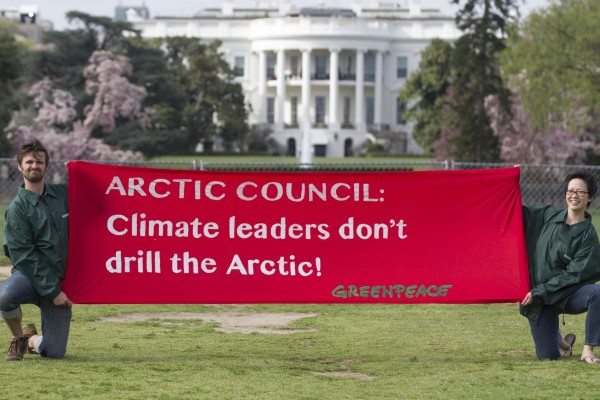The is the second in a two part series on the Arctic Council Chairmanship transition. The first part looking back on Canada’s term as chair can be found here.
As the US assumes the chairmanship of the Arctic Council from Canada at this weeks Ministerial Meeting in Iqaluit, this new role has great significance for residents in Alaska and the rest of the North and hopefully fosters more awareness about the Arctic among the rest of the American public and the world. It underscores the responsibility and opportunity the US has to steer the Arctic Council back toward its inaugural mandate of environmental protection and sustainable development, from which its strayed in the past few years.
Recent speeches made by retired Coast Guard Commandant Adm. Robert Papp, now the Special Representative to the Arctic, and the proposed Arctic Council agenda point the US chairmanship toward a much-needed focus on environmental protections and issues that impact the people of the North and the entire planet. The test, of course, will be whether the US, under the leadership of Secretary John Kerry, successfully leads the Arctic Council toward its stated goals.
The theme of the US chairmanship, One Arctic: Shared opportunities, challenges, and responsibilities, encompasses three proposed thematic areas:
Arctic Ocean safety, security and stewardship this includes improving search and rescue ability and infrastructure, addressing marine environmental protection, and addressing Arctic Ocean acidification.
Improving economic and living conditions this will include demonstrations of renewable energy projects in the region, addressing water and sanitation challenges, and suicide prevention and economic resilience.
Addressing the impacts of climate change this will include more research to address short-term climate change drivers black carbon and methane, improve Arctic climate science, and address climate adaptation and resilience.
This preliminary agenda gives reason for cautious optimism. It also leaves room for improvements and recommendations to make the most of the next two years.
Greenpeaces Recommendations for the US Chairmanship

Greenpeace members hold a banner in front of the White House to remind the Arctic Council that oil drilling in the region goes against its inaugural mandate of environmental protection and sustainable development.
Lead by Example: No Offshore Arctic Drilling
While the inclusion of climate change among the US agenda signals a positive shift in Arctic Council priorities, this may prove more challenging now, given the Obama Administrations recent approval for offshore oil and gas lease sales in the Chukchi Sea. Along with the expected approval of Shell Oils Exploration Plan and final drilling permits, this will allow the company to proceed with its controversial drilling plans this summer. Just as President Obama is right in scrutinizing the Keystone XL pipeline proposal for its climate emissions, so he should with Arctic Ocean drilling. Doing otherwise is hypocritical and could undermine efforts by the US Arctic Council team to facilitate meaningful conversations on climate change, including the aforementioned topics of ocean acidification and climate change adaptation and resilience. How can another Arctic nation take the US seriously about climate change if its opening the door to further fossil fuel dependence and worsening climate change at home?
Support an Arctic Sanctuary
The US should seize the opportunity to propose an Arctic Sanctuary for the uninhabited, high seas region of the central Arctic Ocean (aka the donut hole within the Arctic coastal territories). This proposed sanctuary would be part of a network of marine reserves in the Arctic Ocean that are off limits to extraction and industrial-scale fishing, giving the vulnerable region a greater chance for climate change adaptation.
Several factors support the US taking this opportunity. In 2013, the Finnish government publicly supported an Arctic Sanctuary and is in a place to help see it to fruition as the next Arctic Council Chair; the European Parliament also supported it in 2014. In 2009, the US enacted a commercial ban on industrial-scale fishing in domestic Arctic waters and there is the strong momentum toward a global ban on industrial-scale fishing in the previously unfished waters of the Arctic high seas. The UN Convention on Biodiversity recognizes the area as an Ecologically and Biologically Significant Area. What is needed now is leadership from the Arctic Council to move the conversation forward among nations and Permanent Participants.

Floating ice in the Arctic Ocean. As the Arctic melts, the impacts of climate change are being felt acutely by local residents.
Increase funding and support for Permanent Participants
The Indigenous Peoples of the Arctic should receive greater and more consistent long-term funding and support to participate in conversations and shape decisions within the Arctic Council. The Ottawa Declaration, the founding document of the Arctic Council, states the inclusion of Permanent Participants was intended to provide for active participation and full consultation with the Arctic Indigenous representatives within the Arctic Council. However, Arctic states have not stepped up to adequately support this vision and the US should take appropriate steps to do so during its chairmanship.
Renewable Energy Sector to the Sustainable Development Working Group
If the US wants the Arctic Council to take seriously its goals to improve the economic and living conditions in the region, demonstrate renewable energy projects, and address adaptation to climate change, it should require the Sustainable Development Working Group to consult heavily with renewable energy business interests in the region. Contrary to the Arctic Economic Councils preference for larger fossil fuel interests, the Sustainable Development Working Group should require regional renewable energy experts and businesses to be included in demonstrations and the execution of permanent projects moving forward. This will help to better understand and serve the immediate energy needs of residents, encourage local job growth, and help to drive the development of a clean energy infrastructure.
Push for Internal Reform to Improve the Arctic Councils Effectiveness
The Arctic Council is a critical forum for conversations and collaboration among members. However, it could be significantly more effective and its positions more meaningful if the council itself made serious reforms. These could include, for example, mandatory, council-wide adoption of policies and accountability measures to ensure their implementation, rather than the optional participation in important policies that require full engagement and accountability to be effective.
Admiral Papp has said the US will ramp up the Arctic Councils activities, that it needs to put the Arctic Council on steroids; this is definitely needed after the lack of action under the Canadian chairmanship. Greenpeace calls on the US to employ bold leadership during its chairmanship to redirect the Arctic Council toward environmental protection the Arctic so badly needs.



